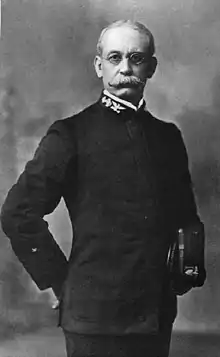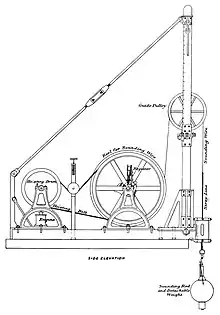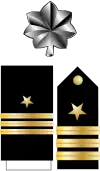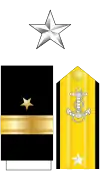Charles Dwight Sigsbee
Charles Dwight Sigsbee (January 16, 1845 – July 13, 1923) was a rear admiral in the United States Navy. In his earlier career he was a pioneering oceanographer and hydrographer. He is best remembered as the captain of USS Maine, which exploded in Havana harbor, Cuba, in 1898. The explosion set off the events that led up to the start of the Spanish–American War.
Charles Dwight Sigsbee | |
|---|---|
 Rear Admiral Charles D. Sigsbee | |
| Born | January 16, 1845 Albany, New York, US |
| Died | July 13, 1923 (aged 78) New York City, US |
| Place of burial | |
| Allegiance | |
| Service/ | |
| Years of service | 1862–1907 |
| Rank | |
| Commands held | USS Maine USS Texas South Atlantic Squadron |
| Battles/wars | American Civil War |
| Signature | |
Biography

Sigsbee was born in Albany, New York, and educated at The Albany Academy. He was appointed acting midshipman on 16 July 1862.
Sigsbee fought in numerous engagements during the Civil War, mostly against Confederate forts and batteries. Sigsbee served aboard Monongahela, Wyoming, and Shenandoah from 1863 to 1869, when he was assigned to duty at the Naval Academy. In 1871, he was assigned to the Hydrographic Office. He was first posted to the Hydrographic Office in 1873. He was assigned to the Coast Survey in 1874 and commanded the Coast Survey steamer Blake from 1875 to 1878. He returned to the Navy Hydrographic Office from 1878–1882 and served as Hydrographer in the Bureau of Navigation from 1893 to 1897. During his period on Blake he developed the Sigsbee sounding machine which became a standard item of deep-water oceanographic equipment for the next 50 years.
Sigsbee served at the Naval Academy from 1869–1871, 1882–1885, and 1887–1890. During this same period he served on the Board of Control for the United States Naval Institute. He commanded Kearsarge on the European station 1885–1886 and the training ship Portsmouth 1891–1892.

Sigsbee took command of the armored cruiser Maine in April 1897. After Maine was destroyed in February 1898, Sigsbee and his officers were exonerated by a court of inquiry. Subsequently he commanded St. Paul in 1898 at the Second Battle of San Juan and Texas until 1900.
In February of that year he was appointed Chief Intelligence Officer of the Office of Naval Intelligence, succeeding Commander Richardson Clover; he held this post until April 1903 when he was succeeded by Commander Seaton Schroeder. He was promoted to rear admiral on 10 August 1903.
He assumed command of the South Atlantic Squadron in 1904, and the Second Division, North Atlantic Squadron in 1905.
Rear Admiral Sigsbee commanded USS Brooklyn as his flagship on June 7, 1905, when she sailed for Cherbourg, France. There, the remains of the late John Paul Jones were taken aboard and brought back home for his interment at the United States Naval Academy.
Admiral Sigsbee retired from the Navy in 1907 and died in New York, 1923. He is buried in Arlington National Cemetery.[1] His grandson, Charles Dwight Sigsbee III, First Lieutenant, United States Army, was buried next to him on July 10, 1956.
His daughter Mary Ellen Sigsbee (1877–1960),[2] was an artist, socialist and feminist.[3]
Namesake
- The destroyer USS Sigsbee (DD-502) was named for him.
- Sigsbee Park, the primary military family housing area for Naval Air Station Key West, and the collocated Sigsbee Elementary School are named in his honor.
- Sigsbee Deep, the deepest part of the Gulf of Mexico was discovered by ships under his command and it was named in his honor.[4]
- On May 25, 1898, Daniel Bevill was appointed postmaster of a new post office in Shelby County, Missouri, but needed a name for the office. Mr. Bevill had so admired Charles Dwight Sigsbee, a naval officer in command of the battleship Maine which was blown up in Havana Harbor in 1898, that he named the post office site as Sigsbee. (Shelby County Historical Society records)
Ranks held
- Midshipman – September 27, 1859
- Passed Midshipman – 1863
- Master – May 10, 1866
| Ensign | Lieutenant Junior Grade | Lieutenant | Lieutenant Commander | Commander | Captain | Commodore | Rear Admiral |
|---|---|---|---|---|---|---|---|
| O-1 | O-2 | O-3 | O-4 | O-5 | O-6 | O-7 | O-8 |
 |
 |
 |
 |
 |
 |
 |
 |
| October 3, 1863 | Never Held | April 21, 1867 | March 12, 1868 | May 11, 1882 | March 21, 1897 | Unknown | August 10, 1903 |
See also
References
- Burial Detail: Sigsbee, Charles D – ANC Explorer
- "Ker, William Balfour". schoonoverstudios.com. Retrieved June 20, 2019.
- "William Balfour Ker – Artist Biography for William Balfour Ker". Ask Art. Retrieved June 21, 2019.
- "Charles Dwight Sigsbee". The Spanish American War Centennial Website. Retrieved November 27, 2009.
- This article incorporates text from the public domain Dictionary of American Naval Fighting Ships.
- "Sigsbee". Dictionary of American Naval Fighting Ships. Naval Historical Center, Department of the Navy. Archived from the original on March 29, 2004. Retrieved September 5, 2008.
- Hamersly, Lewis Randolph (1898). Charles D. Sigsbee. The Records of Living Officers of the U.S. Navy and Marine Corps (Sixth ed.). L. R. Hamersly & Company. Retrieved April 9, 2007.
External links
| Wikimedia Commons has media related to Charles Dwight Sigsbee. |
| Wikisource has original works written by or about: Charles Dwight Sigsbee |
- Finding Aid to Charles D. Sigsbee Papers, 1858–1923 at the New York State Library, accessed May 18, 2016.
| Preceded by Richardson Clover |
Head of the Office of Naval Intelligence (Chief Intelligence Officer) February 1900 – April 1903 |
Succeeded by Seaton Schroeder |